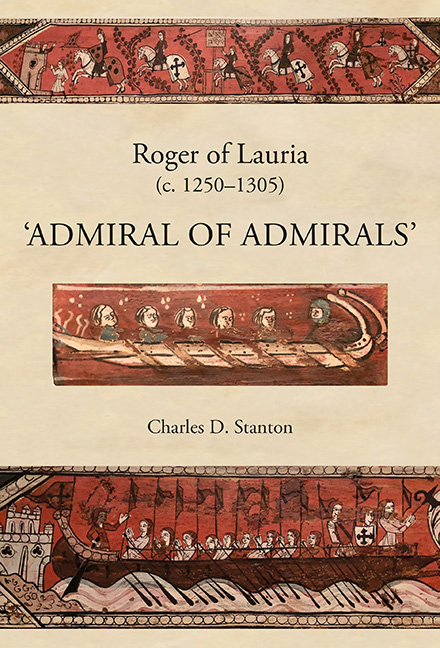Book contents
- Frontmatter
- Dedication
- Contents
- List of Illustrations
- Prologue
- 1 Battle of Benevento (26 February 1266)
- 2 A Calabrian Exile in the Court of Aragon (1262–1282)
- 3 Battle of Tagliacozzo (23 August 1268)
- 4 Aragonese Expansion (1229–1282)
- 5 Angevin Consolidation and Aggrandizement (1268–1282)
- 6 Revolt of the Vespers (30 March 1282)
- 7 Aragonese Intervention (August–October 1282)
- 8 Stalemate (November 1282–March 1283)
- 9 Admiral of Aragon (20 April 1283)
- 10 The Opposing Fleets (1282–1302)
- 11 Battle of Malta (8 June 1283)
- 12 Anjou's Dreams of Empire Dashed (June–November 1284)
- 13 France's Crusade Against Aragon (May–November 1285)
- 14 Battle of the Counts (23 June 1287)
- 15 Truces and Treaties (June 1287–November 1291)
- 16 Raid on Romania (Summer 1292)
- 17 Switching Sides (December 1293–April 1297)
- 18 Aragon's Invasion of Sicily at Anjou's Bidding (1298/1299)
- 19 Lauria's Last Great Campaign (Summer 1299–Spring 1300)
- 20 Endgame (Spring 1301–Summer 1302)
- Epilogue
- Bibliography
- Index
14 - Battle of the Counts (23 June 1287)
Published online by Cambridge University Press: 24 October 2019
- Frontmatter
- Dedication
- Contents
- List of Illustrations
- Prologue
- 1 Battle of Benevento (26 February 1266)
- 2 A Calabrian Exile in the Court of Aragon (1262–1282)
- 3 Battle of Tagliacozzo (23 August 1268)
- 4 Aragonese Expansion (1229–1282)
- 5 Angevin Consolidation and Aggrandizement (1268–1282)
- 6 Revolt of the Vespers (30 March 1282)
- 7 Aragonese Intervention (August–October 1282)
- 8 Stalemate (November 1282–March 1283)
- 9 Admiral of Aragon (20 April 1283)
- 10 The Opposing Fleets (1282–1302)
- 11 Battle of Malta (8 June 1283)
- 12 Anjou's Dreams of Empire Dashed (June–November 1284)
- 13 France's Crusade Against Aragon (May–November 1285)
- 14 Battle of the Counts (23 June 1287)
- 15 Truces and Treaties (June 1287–November 1291)
- 16 Raid on Romania (Summer 1292)
- 17 Switching Sides (December 1293–April 1297)
- 18 Aragon's Invasion of Sicily at Anjou's Bidding (1298/1299)
- 19 Lauria's Last Great Campaign (Summer 1299–Spring 1300)
- 20 Endgame (Spring 1301–Summer 1302)
- Epilogue
- Bibliography
- Index
Summary
HAD IT NOT BEEN FOR A HEADSTRONG pope and a fiercely partisan French knight, the papally sponsored Angevin dream of recovering Sicily would have died along with Philip III of France and his ill-fated Aragonese crusade. Weary of his captivity in Catalonia, Charles of Salerno (heir to Charles I of Anjou) signed an agreement on 27 February 1287, known as the Treaty of Cefalu, in which he renounced his claim to the crown of Sicily in favour of James of Aragon, as a condition of his release. The only problem was that it was not his decision to make. On his deathbed in January 1285, Anjou had designated Robert II, Count of Artois, as regent for the Regno while his son remained incarcerated. When Honorius IV donned the papal pallium in April of that same year as successor to the deceased Martin IV, he reaffirmed Robert's role by appointing him (along with Gerardo da Parma) as his bailiff for the kingdom, which he considered a papal fief. In February of the following year, the new pope went so far as to excommunicate James in response to his coronation as king of Sicily, along with the entire population of the island. So it was no surprise that both Honorius and Robert of Artois rejected, out of hand, Charles the Lame's pact with the Aragonese as a ‘deal with the devil’ done under duress; and then renewed preparations to retake the island. Honorius, himself, passed away in Rome in early April 1287, but by then all was in readiness and Robert, a seasoned soldier, was resolved to see the issue through.
The count of Artois laid claim to a long and loyal connection to the House of Anjou, in principle, and Charles, in particular. His father, Robert I of Artois, was brother to both Charles of Anjou and King Louis IX of France, making Robert II nephew to Charles. Anjou and the senior Artois fought together in the disastrous Seventh Crusade, in which Saint Louis invaded Egypt. In fact, it was while leading an ill-considered cavalry charge at Mansourah in 1250 that Robert I lost his life.
- Type
- Chapter
- Information
- Roger of Lauria (c.1250–1305)‘Admiral of Admirals’, pp. 198 - 209Publisher: Boydell & BrewerPrint publication year: 2019



